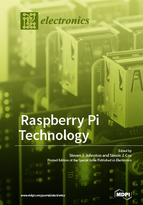Raspberry Pi Technology
A special issue of Electronics (ISSN 2079-9292). This special issue belongs to the section "Computer Science & Engineering".
Deadline for manuscript submissions: closed (30 April 2016) | Viewed by 162092
Special Issue Editors
Interests: High Performance Computing and Data; Internet of Things; computational methods; algorithms; commodity computing
Interests: Internet of Things; smart city; air quality; cloud computing; embedded devices and sensors
Special Issues, Collections and Topics in MDPI journals
Special Issue Information
Dear Colleagues,
The Raspberry Pi has been very influential in introducing embedded systems to a more general audience, resulting in their novel use in a wide range of applications and areas. The aim of this Special Issue is to capture and present feature and scholarly papers from a wide range of topics related to Electronics.These topics include but are not limited to: Internet of things devices and gateways; low cost and disposable compute; sensor networks; remote sensing; low power solutions; non-traditional security devices; industrial and scientific/engineering applications and any other related novel applications of the Raspberry Pi eco system.
We invite scientists and researchers from all fields of electronics, computer science, and applied science and engineering fields to submit papers for this Special Issue of Electronics. Case studies, reviews, and research papers on all topics related to the novel use of the Raspberry Pi are invited.
Prof. Simon J. Cox
Dr. Steven J Johnston
Guest Editors
Manuscript Submission Information
Manuscripts should be submitted online at www.mdpi.com by registering and logging in to this website. Once you are registered, click here to go to the submission form. Manuscripts can be submitted until the deadline. All submissions that pass pre-check are peer-reviewed. Accepted papers will be published continuously in the journal (as soon as accepted) and will be listed together on the special issue website. Research articles, review articles as well as short communications are invited. For planned papers, a title and short abstract (about 100 words) can be sent to the Editorial Office for announcement on this website.
Submitted manuscripts should not have been published previously, nor be under consideration for publication elsewhere (except conference proceedings papers). All manuscripts are thoroughly refereed through a single-blind peer-review process. A guide for authors and other relevant information for submission of manuscripts is available on the Instructions for Authors page. Electronics is an international peer-reviewed open access semimonthly journal published by MDPI.
Please visit the Instructions for Authors page before submitting a manuscript. The Article Processing Charge (APC) for publication in this open access journal is 2400 CHF (Swiss Francs). Submitted papers should be well formatted and use good English. Authors may use MDPI's English editing service prior to publication or during author revisions.
Keywords
- Internet of Things applications and drivers
- Low cost devices
- Sensor networks
- Remote sensing
- Low power solutions
- Evaluation and testbeds
- Novel and unique ways of using a Raspberry Pi







